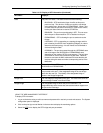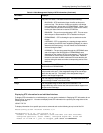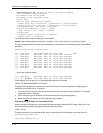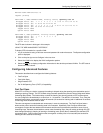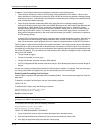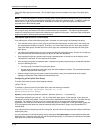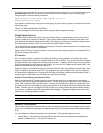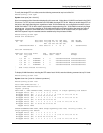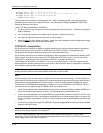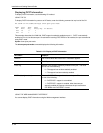
Installation and Getting Started Guide
Fast Uplink Span group on the device. All Fast Uplink Span ports are members of the same Fast Uplink Span
group.
NOTE: To avoid the potential for temporary bridging loops, Hewlett-Packard recommends that you use the Fast
Uplink feature only for wiring closet switches (switches at the edge of the network cloud). In addition, enable the
feature only on a group of ports intended for redundancy, so that at any given time only one of the ports is
expected to be in the forwarding state.
NOTE: When the wiring closet switch (HP device) first comes up or when STP is first enabled, the uplink ports
still must go through the standard STP state transition without any acceleration. This behavior guards against
temporary routing loops as the switch tries to determine the states for all the ports. Fast Uplink Span acceleration
applies only when a working uplink becomes unavailable.
Fast Uplink Span Rules for Trunk Groups
If you add a port to a Fast Uplink Span group that is a member of a trunk group, the following rules apply:
• If you add the primary port of a trunk group to the Fast Uplink Span group, all other ports in the trunk group
are automatically included in the group. Similarly, if you remove the primary port in a trunk group from the
Fast Uplink Span group, the other ports in the trunk group are automatically removed from the Fast Uplink
Span group.
• You cannot add a subset of the ports in a trunk group to the Fast Uplink Span group. All ports in a trunk group
have the same Fast Uplink Span property, as they do for other port properties.
• If the working trunk group is partially down but not completely down, no switch-over to the backup occurs.
This behavior is the same as in the standard STP feature.
• If the working trunk group is completely down, a backup trunk group can go through an accelerated transition
only if the following are true:
• The trunk group is included in the fast uplink group.
• All other ports except those in this trunk group are either disabled or blocked. The accelerated transition
applies to all ports in this trunk group.
• When the original working trunk group comes back (partially or fully), the transition back to the original
topology is accelerated if the conditions listed above are met.
Configuring a Fast Uplink Port Group
To enable Fast Uplink, use one of the following methods.
USING THE CLI
To configure a group of ports for Fast Uplink Span, enter the following commands:
HP9300(config)# fast uplink-span ethernet 4/1 to 4/4
HP9300(config)# write memory
Syntax: [no] fast uplink-span [ethernet <portnum> [ethernet <portnum>… | to <portnum>]]
This example configures four ports, 4/1 – 4/4, as a Fast Uplink Span group. In this example, all four ports are
connected to a wiring closet switch. Only one of the links is expected to be active at any time. The other links are
redundant. For example, if the link on port 4/1 is the active link on the wiring closet switch but becomes
unavailable, one of the other links takes over. Because the ports are configured in a Fast Uplink Span group, the
STP convergence takes about four seconds instead of taking 30 seconds or longer using the standard STP
forward delay.
If you add a port that is the primary port of a trunk group, all ports in the trunk group become members of the Fast
Uplink Span group.
You can add ports to a Fast Uplink Span group by entering the fast uplink-span command additional times with
additional ports. The device can have only one Fast Uplink Span group, so all the ports you identify as Fast Uplink
Span ports are members of the same group.
5 - 16




